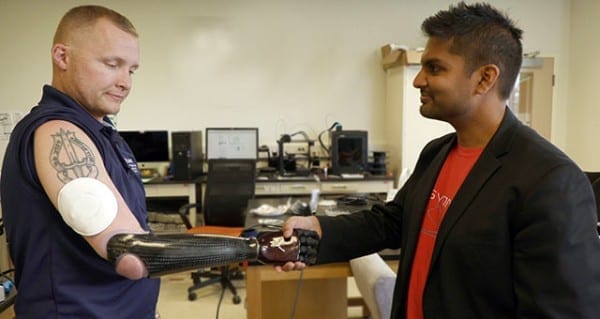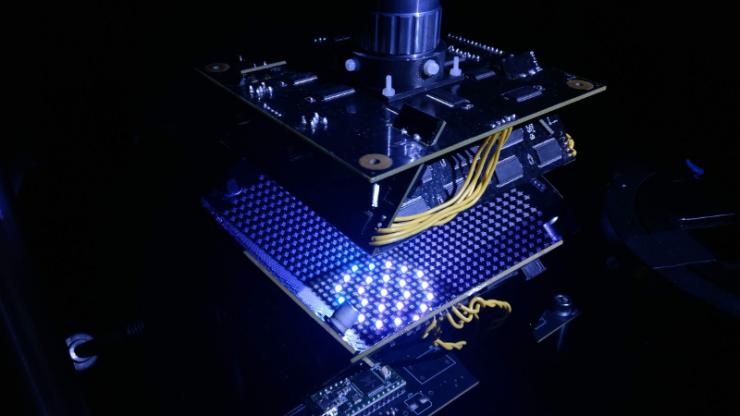
Imagine holding hands with a loved one on the other side of the world. Or feeling a pat on the back from a teammate in the online game “Fortnite.”
Northwestern University researchers have developed a new thin, wireless system that adds a sense of touch to any virtual reality (VR) experience. Not only does this platform potentially add new dimensions to our long-distance relationships and entertainment, the technology also provides prosthetics with sensory feedback and imparts telemedicine with a human touch.
Referred to as an “epidermal VR” system, the device communicates touch through a fast, programmable array of miniature vibrating actuators embedded into a thin, soft, flexible material. The 15-centimeter-by-15-centimeter sheet-like prototypes comfortably laminate onto the curved surfaces of the skin without bulky batteries and cumbersome wires.
“People have contemplated this overall concept in the past, but without a clear basis for a realistic technology with the right set of characteristics or the proper form of scalability. Past designs involve manual assemblies of actuators, wires, batteries and combined internal and external control hardware,” said Northwestern’s John A. Rogers, a bioelectronics pioneer. “We leveraged our knowledge in stretchable electronics and wireless power transfer to put together a superior collection of components, including miniaturized actuators, in an advanced architecture designed as a skin-interfaced wearable device — with almost no encumbrances on the user. We feel that it’s a good starting point that will scale naturally to full-body systems and hundreds or thousands of discrete, programmable actuators.”
“We are expanding the boundaries and capabilities of virtual and augmented reality,” said Northwestern’s Yonggang Huang, who co-led the research with Rogers. “By comparison to the eyes and the ears, the skin is a relatively underexplored sensory interface that could significantly enhance experiences.”
The research will be published on Nov. 21 in the journal Nature.
How it works
Rogers and Huang’s most sophisticated device incorporates a distributed array of 32 individually programmable, millimeter-scale actuators, each of which generates a discrete sense of touch at a corresponding location on the skin. Each actuator resonates most strongly at 200 cycles per second, where the skin exhibits maximum sensitivity.
“We can adjust the frequency and amplitude of each actuator quickly and on-the-fly through our graphical user interface,” Rogers said. “We tailored the designs to maximize the sensory perception of the vibratory force delivered to the skin.”
The patch wirelessly connects to a touchscreen interface (on a smartphone or tablet). When a user touches the touchscreen, that pattern of touch transmits to the patch. If the user draws an “X” pattern on the touchscreen, for example, the devices produce a sensory pattern, simultaneously and in real-time, in the shape of an “X” through the vibratory interface to the skin.
When video chatting from different locations, friends and family members can reach out and virtually touch each other — with negligible time delay and with pressures and patterns that can be controlled through the touchscreen interface.
“You could imagine that sensing virtual touch while on a video call with your family may become ubiquitous in the foreseeable future,” Huang said.
The actuators are embedded into an intrinsically soft and slightly tacky silicone polymer that adheres to the skin without tape or straps. Wireless and battery-free, the device communicates through near-field communication (NFC) protocols, the same technology used in smart phones for electronic payments.
You could imagine that sensing virtual touch while on a video call with your family may become ubiquitous in the foreseeable future.”
“With this wireless power delivery scheme, we completely avoid the need for batteries, with their weight, size, bulk and limited operating lifetimes,” Rogers said. “The result is a thin, lightweight system that can be worn and used without constraint, indefinitely.”
Veteran describes importance of sensory feedback
Everyone can imagine how this type of technology could be combined with a VR headset to create more interactive and immersive gaming or entertainment experiences. But for U.S. Army veteran Garrett Anderson, epidermal VR might provide a much-needed solution to a real-life problem.
At 4 a.m. on Oct. 15, 2005, Anderson was ambushed during his deployment in the Iraq War and lost his right arm just below the elbow.
“A bomb exploded under my truck,” Anderson said. “It blew the entire engine out of the vehicle. Then shrapnel came through the vehicle and severed my arm, which was hanging on by tendons.”
Anderson recently tried Northwestern’s system, integrated with his prosthetic arm. When wearing the patch on his upper arm, Anderson could feel sensations from his prosthetic fingertips transmitted to his arm. The vibrations felt more or less intense, depending on the firmness of his grip.
I need to know the amount of grip that I’m applying, so that I don’t hurt something or someone.”
Sgt. Garrett Anderson
U.S. Army veteran
“Say that I’m grabbing an egg or something fragile,” said Anderson, who is now the outreach coordinator at the University of Illinois’ Chez Veterans Center. “If I can’t adjust my grip, then I might crush the egg. I need to know the amount of grip that I’m applying, so that I don’t hurt something or someone.”
‘I have never felt them with my right arm’
As people who have had amputations use the device, the experience could become more seamless.
“Users develop an ability to sense touch at the fingertips of their prosthetics through the sensory inputs on the upper arm,” Rogers explained. “Overtime, your brain can convert the sensation on your arm to a surrogate sense of feeling in your fingertips. It adds a sensory channel to reproduce the sense of touch.”
Anderson believes this device could potentially “trick” his brain in a way that relieves phantom pain. He also imagines that it could allow him to interact with his children in a new way.
“I lost my arm 15 years ago,” he said. “My kids are 13 and 10, so I have never felt them with my right arm. I don’t know what it’s like when they grab my right hand.”
‘A starting point’
Rogers views the current device as a starting point. “This is our first attempt at a system of this type,” he said. “It could be very powerful for social interactions, clinical medicine and applications that we cannot conceive of today, beyond the obvious opportunities in gaming and entertainment.”
He and Huang are already working to make the current device slimmer and lighter. They also plan to exploit different types of actuators, including those that can produce heating and stretching sensations. With thermal inputs, for example, a person might be able to sense how hot a cup of coffee is through prosthetic fingertips.
The Northwestern team believes the overall engineering framework can accommodate hundreds of actuators with dimensions significantly smaller than those used currently, which have diameters of 18 millimeters and thicknesses of 2.5 millimeters.
Eventually, the devices could be thin and flexible enough to be woven into clothes. People with prosthetics could wear VR shirts that communicate touch through their fingertips. And along with VR headsets, gamers could wear full VR suits to become fully immersed into fantastical landscapes.
“Virtual reality is a very important emerging area of technology,” Rogers said. “Currently, we’re just using our eyes and our ears as the basis for those experiences. The community has been comparatively slow to exploit the body’s largest organ: the skin. Our sense of touch provides the most profound, deepest, emotional connection between people.”
Learn more: ‘Epidermal VR’ gives technology a human touch
The Latest on: Virtual reality
- Virtual Reality Italian Cooking App Demonstrated for Italian 2003, 1013 Courseson May 2, 2024 at 10:16 pm
Students in the two Italian courses donned virtual-realty headsets and hand guides to practice cooking in a virtual setting while also giving commands in Italian and better learning the language.
- Mice navigating a virtual reality environment reveal that walls, not floors, define spaceon May 2, 2024 at 12:29 pm
"Our findings provide a significant step forward in understanding the precise nature of the sensory information that animals used for boundary detection," says Dr. Chen. "They not only highlight the ...
- Virtual reality could revolutionize mental-health treatments, including ketamine therapy, for conditions like depression and anxietyon May 2, 2024 at 7:25 am
Here's how virtual reality is transforming mental-health treatments such as ketamine therapy for conditions like depression, PTSD, and body dysmorphia.
- Virtual reality: A promising tool for teen stress reductionon May 1, 2024 at 5:00 pm
In response to this crisis, University of Washington researchers studied whether virtual reality might help reduce stress for teens and boost mental health. Working with adolescents, the team designed ...
- Virtual reality could help treat eating disorders, Louisville researchers sayon May 1, 2024 at 1:05 pm
Kentucky researchers are developing and expanding a virtual reality treatment for eating disorders using a $125,000 grant from the National Eating Disorders Association, the University of Louisville ...
- 3 Virtual Reality Stocks Worth Strapping Into Nowon April 30, 2024 at 5:08 am
The virtual reality (VR) stocks and trends are lukewarm, even cold, compared to just a few years ago. Undoubtedly, the big tech titans, including some Magnificent Seven firms you may be familiar with, ...
- Shhh! 3 Secret Virtual Reality Stocks Flying Below Wall Street’s Radaron April 30, 2024 at 3:35 am
InvestorPlace - Stock Market News, Stock Advice & Trading Tips Thanks to weaker-than-expected forecasts, top virtual reality (VR) stocks ...
- Researchers develop a new way to instruct dance in Virtual Realityon April 29, 2024 at 3:22 pm
Virtual reality dance made easier with crowd wave technique. Open source code can be downloaded for Quest 2 and 3.
- How Virtual Reality Fits Into Blended Learning At Workon April 29, 2024 at 11:54 am
“Blended learning” refers to a combination of digital and in-person instruction. Typically, the digital element takes place online via 2D videos. While 2D videos work well in certain cases, they can ...
- Virtual Reality Newson April 28, 2024 at 5:00 pm
Bringing Together Real-World Sensors and VR to Improve Building Maintenance Jan. 31, 2024 — A new system that brings together real-world sensing and virtual reality would make it easier for ...
via Bing News
The Latest on: Epidermal VR
- 20 Best VR Porn Games to Play in 2024on April 30, 2024 at 5:00 pm
Virtual reality (VR) porn is far more immersive than traditional, 2D porn. But what if we told you that there’s an even more fun and immersive VR porn experience? Well, there is, and it lies in ...
- Samsung XR/VR headset – everything we know so far and what we want to seeon April 30, 2024 at 2:15 am
A new Samsung XR/VR headset is coming according to the manufacturer itself, and we couldn't be more excited too see what this so-called Apple Vision Pro rival (an XR headset from Apple ...
- The best VR headset in 2024: all the latest platforms comparedon April 29, 2024 at 9:30 am
The best VR headset for you may not be the best for everyone. There's a wider range of headsets than ever before, so if you're only interested in gaming, it's likely that your best bet will differ ...
- Pimax Says ‘VR Station’ PC VR Console is Still in Developmenton April 24, 2024 at 5:00 pm
Two and a half years ago, Pimax announced VR Station, a compact, console-like computer for running PC VR content that would be wirelessly streamed to its Reality “12K” and Crystal headsets.
- Best VR Headsets for PCon April 23, 2024 at 2:32 am
Over the years, the burgeoning world of VR has grown from its humble beginnings to wider accessibility. And when you’ve got a VR headset connected to the best gaming PC, these devices can do ...
- Best Racing VR Games For The Oculus Quest 2on April 15, 2024 at 7:45 pm
For gamers on the Oculus Quest 2, here are some of the best racing titles. VR gaming offers immersive experiences, from solving crimes to racing fast cars, providing an escape from reality.
- Best VR Headset in 2024on April 15, 2024 at 3:20 am
Combining quality VR and affordability, the Meta Quest 3 is our favorite VR headset you can buy in 2024, but there are plenty of powerful alternatives that deliver an incredibly immersive experience.
- The Best VR Headsets for 2024on April 14, 2024 at 5:00 pm
I’ve reviewed more than a thousand different consumer electronics products including headphones, speakers, TVs, and every major game system and VR headset of the last decade. I’m an ISF ...
- The Best Free Virtual Reality Gameson April 13, 2024 at 11:16 pm
There are a lot of great VR games out there that players can enjoy for free. Here's a look at some of the absolute best. Your browser does not support the video tag ...
- 12 Best VR Porn Sites: Find Hot VR Porn Videos in 2024on April 10, 2024 at 3:27 am
We are living in an age that feels like an episode of Black Mirror. VR has created an alternative reality where users can be fully immersed in any experience. With the invention of virtual reality ...
via Bing News










